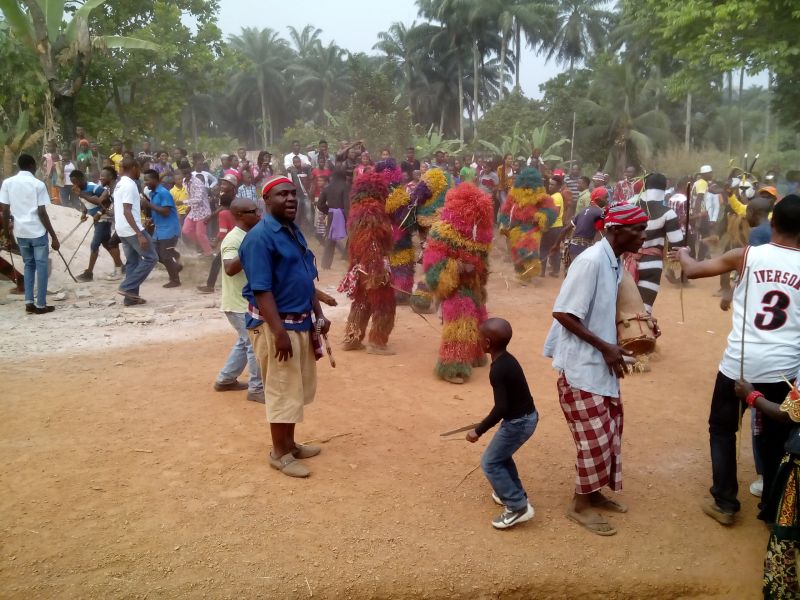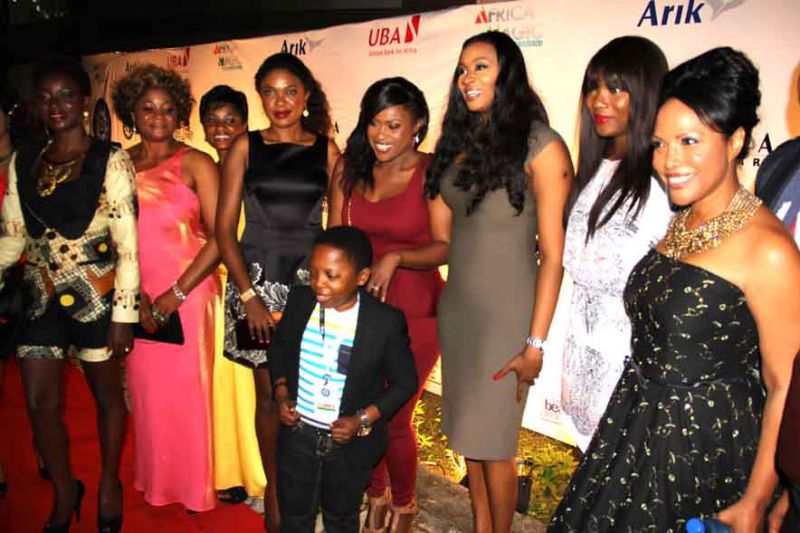Ovim: the 21 days of fun
Posted by admin | 10 years ago | 14,934 times

One of the many festivals that took place in Ovim during its 2014/2015 harvest season was the Ajonkwu Festival, held at Amaeke-elu. Factnewsonline was on hand to record some of the sensational events of that day.
Ovim, located in Isuikwuato Local Government Area (LGA) in Abia State, was a centre of huge celebrations few days ago. Indeed, a few days’ visit to the cozy, safe and secured town shows that the people’s culture is still very much alive and well.
On Sunday, January 4, 2015, two men – standing about a pole apart, near the edge of the village-square – stood facing each other. In the midst of the day’s excitement, they were the cynosure of all eyes as their next action was going to be very important in the next stage of the day’s activities. The time was about 6: 05 in the evening.
Few seconds later, they looked away from each to take quick glances around them, just to get their bearings right. Then, in less than no time, they faced each other again, but this time as if in a telepathic communication.
These actions took place at a point during the last 2015 Ajonkwu Festival held at Amaeke-elu, Ovim. One of the men was the man in the masquerade, the Ajonkwu. He was swaying with grace in an ecstatic mood, and in response to the Chanchankoro rhythm of the Ajonkwu music playing at the village-square.
The other man was Egbuchulam Ajala – not in a masquerade, but clutching to a long-gun and in his own peculiar way also swayed ecstatically to the rhythm of the music coming from behind him.
The masquerade was facing the village-square, ready to charge into it at the right moment; Ajala was backing the square about to release the gunshot that will send it charging into the arena. The masquerade charging into the arena would usher in the most energetic aspect of the day’s events.
The two danced, gesticulated and demonstrated in sheer pleasure to the delight and amusement of those in the part of the crowd they were visible to. Thrilled with the spectacle on display, the rumble of the crowd’s shouts and rowers could be heard miles away. The stands were packed full, and the spectators – men, women and children – were enjoying every bit of the scenes before them.
Patiently Ajala waited, biding his time while still swaying to the rhythm of the “chanchankoro” sound playing in the background. He was to perform that singular act known as “Igbasu Ejonkwu”. Few minutes later, he was ready, primed and composed, and at that point, he was just waiting for the appropriate distance between him and the Ajonkwu, to release that all-important shot.
The Ajonkwu on its part was prancing around with majestic gait, occasionally pacing and jumping from place to place, and also occasionally swaying to the rhythm of the music in the background. At about 6: 34 PM, he was signaled to that the time for that important shot was up. He was ready for it, so he started advancing steadily towards Ajala.
Four minutes gone, three minutes, two minutes and then one! At about 6: 39 pm it happened. And as the gun boomed in the hand of Ajala, the Ajonkwu charged forward in majestic elegance. As he raced after Ajala and the young men behind him, the guns, and all manner of knockout bangers began to boom in quick succession all around the arena. Ajala and all the other young people standing behind him ran from it into the arena.
With both hands raised above its head in celebration – the Opia on the left, and a designed sword on the right – the next and most energetic and final phase of the 2015 Ajonkwu festival had commenced. It charged forward into the arena.
The Ajonkwu stopped briefly to get blessing from an elder from the Umueye side of the arena, and then continued. The people were thrilled and tumultuous. Shouts of excitements accompanied the booming of all manner of guns and Knockout bangers. The Ajonkwu raced from one corner of the square to the other pursuing the men who were shooting the guns.
After some dancing, running and chasing here and there, and some more booming of guns, the Ajonkwu suddenly swerved away from the people and headed towards Ohonja, the adjacent community. It disappeared out of sight and the people erupted in ecstatic enjoyment, as those in the arena started chorusing, “Chowe ogaru ole? Chowe ogaru ole? – Search for him, where has he gone to.” As they sang they jumped around from one corner of the arena to the other – the tempo of fun rising as the minutes ticked by.
In another corner, the songs changed to “Odu mma maru onwe ya, l’iwe du okekpe akaria la, iwe! – Let all be mindful, the anger of Okekpe (another name for Ajonkwu) is much. The song is a warning that people should keep away from its path, that its anger was hot – meaning that it was ready to touch someone with its Opia.
Whoever it touches with the contraption in its left hand, known as Opia usually pays some heavy fine. It also gives such an individual an image of a lazy weakling who could not outrun the Ajonkwu to get out of its part. So even though the young men (and women) were joyful and appreciative of being chased about by the masquerade, none of them was ready to be touched with the Opia.
That was the excitement of the day, and that was the joy of the Ajonkwu festival every year.
Few minutes later, it came back through the same route, performed the same action dancing and chasing, and went out through the road leading towards the ancient Ovim settlement – Nkwo Ovum. It appeared again through the Onuoha-Odu side of the village-square, after it had entered the Ikoro to greet and acknowledge the elders there.
Then it did some dancing in front of the Chanchankoro music players, went into the middle of the square; did some more dancing and chasing-around before he was caught. That was the ended of the Amaeke-elu Ajonkwu festival for 2015.
Joyfully, older women greeted each other with the statement “oghabukwa aka o!” – meaning that it will be till next year before the next Ajonkwu Amaeke will happen again.
After all said and done, Factnewsonline gathered that it is the fun of Ajonkwu festival – the songs and their meanings; the singing and drumming and dancing – that move the people every year, either to come and participate or to watch. Even the stunts of climbing trees and jumping off them; of shooting and the Ajonkwu coming after you, are what motivate a lot of other people.
Emeka Ejimofor, a Deputy Director in Abia State Ministry of Justice, had this to say about the 2015 celebration of the Ajonkwu festival: “It was a thrilling one, better than we have had it for some years now.” He was particularly happy that it was done peacefully, and without any disagreement leading to violence or fights.
The Ajonkwu festival usually has two masquerades, the male and the female. The male is organised in such a way that it runs after any one that shoots in the arena. That is the essence of its chasing men about on the arena.
The female Ajonkwu usually enters the arena before the male. Its own business is always to move around with the grace of a female, showcasing especially all the engendering mannerisms of the womenfolk. Of course, it also dances to delight the people.
Usually heavy shooting starts particularly when the female Ajonkwu is to leave the arena. It is the gun shots that usually send it away. As the shooting starts, it would just cover its ears with both hands like a frightened woman and frantically, but with the graceful strides of a noble woman, run off the arena.
So, while the female Ajonkwu is known for its grace and regal dance-steps, the male is known for its athleticism of running around the arena – chasing the men that shoot guns and attempting to touch them with its Opia.
Interestingly, the Ajonkwu-Amaeke Festival is just one of the numerous festivals and celebrations held in the year in Ovim. As a matter of fact, the 2015 Ajonkwu-Amaeke festival was the last in the 2014/2015 edition. That of Umuenya in Obayi; and Amuzu, a branch of Amaeke, was held days earlier.
The last Omume Ovum, which some people tagged the Ovim 21 days of fun, started at Obayi on December 17, and ended on January 7, at Umudinja (another branch of the extended Amaeke family). Umudinja like Amuzu are branches of the Amaeke clan living outside their ancestral location.
Every year, during the harvest/dry season – which is usually between December and January – Ovim people always engaged in these celebrations known as Omume Okochi ofOmume Ovum. It is usually held across each clan, satellite communities known as Isiama. There are five Isiama in Ovim: Ohoroho, Ohonja, Amune, Obayi, and Amaeke. The five are descendants of the five sons of Ovum (the real name of Ovim). Each of them always has a day or two for one or two (and in some cases three or four) activities in celebration of their Omume. The Omume Okochi is an age-long practice, which the people use as recreation after farming and harvesting had ceased. It is usually a time of merry-making across all the Isiama, eating and drinking; dancing, singing and having fun in the thick of dry/harvest season, take place.
For instance, Ohoroho has Oriri Uzo and Oso Ekpo, which they usually celebrate together with other clans like Ohonja and Amaeke. Ohonja has Okerenkwa, Itembe and Oso Ekpo; Amune has Ajonkwu and Edere; Amaeke has Ajonkwu, Ekpo and Edere; While Obayi has Ngidi and Oso Ekpo.
Some parts of these clans have also had to initiate and organise their own festivals as is the case with Ugwunta, which is a part of Ohoroho and which organises its own Ajonkwu; Umuenya Chief Oji, which also organises Ajonkwu; as well as Umudinja, which has its Oba and Oso Ekpo. However, what is important in the Ajonkwu of Umuenya and Ugwunta (parts of Ohoroho and Obayi, respectively) is that they are not in the Omume Okochicalendar of Ovim. The dates of their celebrations are fixed at the convenience of the people.
Instructively, Ovum Calender is tired to that of Imenyi with Ahaba as head. Imenyi is the parent of Ahaba, Ezere and Ovum.
The question to our readers is have you ever been to Ovim during its dry season celebrations? If no, then it is something you must have to give a try one of these years. Welcome to the New Year!
Readers Comments
comment(s)
No comments yet. Be the first to post comment.








